#Littorinidae
Explore tagged Tumblr posts
Text
Uncharismatic Fact of the Day
Identifying species can be an extremely difficult job for biologists-- especially when the animal in question has too few distinguishing features, or too many. Perhaps no species demonstrates this better than Littorina saxatilis, aka the rough periwinkle snail. Due to the extreme variations in shell shape, size, and color, this species has been misidentified by taxonomists 112 times! Even today, scientists are still in dispute over whether genetically distinct populations should be considered separate species.

(Image: Six rough periwinkle snails (Littorina saxatilis) by Sue Scott)
Want to request some art or uncharismatic facts? Just send me proof of donation of any amount to any of the fundraisers on this list, or a Palestinian organization of your choice!
Bonus: check out the list of L. saxatilis' former names below the cut!
Litorina groenlandica Menke, 1830
Litorina incarnata Philippi, 1846
Litorina marmorata L. Pfeiffer, 1839
Litorina sulcata Menke, 1830
Littorina castanea Deshayes in Deshayes & Milne Edwards, 1843
Littorina danieli Locard, 1886
Littorina groenlandica (Menke, 1830)
Littorina neglecta Bean, 1844
Littorina nervillei Dautzenberg, 1893
Littorina nervillei var. major Pallary in Seurat, 1924
Littorina nigrolineata Gray, 1839
Littorina palliata var. turritella Schlesch, 1916
Littorina rudis (Maton, 1797) (synonym)
Littorina rudis f. elatior Middendorff, 1849
Littorina rudis var. albida Dautzenberg, 1887
Littorina rudis var. alticola Dacie, 1917
Littorina rudis var. aurantia Dautzenberg, 1887
Littorina rudis var. brevis Dautzenberg, 1887
Littorina rudis var. conoidea Schlesch, 1916
Littorina rudis var. fasciata Dautzenberg, 1887
Littorina rudis var. finmarchia Herzenstein, 1885
Littorina rudis var. globosa Jeffreys, 1865
Littorina rudis var. globosa Martel, 1901
Littorina rudis var. laevis Jeffreys, 1865
Littorina rudis var. major Dautzenberg & P. Fisher, 1912
Littorina rudis var. rubescens Monterosato, 1878
Littorina rudis var. scotia S.M. Smith, 1979
Littorina rudis var. similis Jeffreys, 1865
Littorina rudis var. sulcata Martel, 1901
Littorina rudis var. tenebrosapallida L.E. Adams, 1896
Littorina rudis var. tessellata Dautzenberg, 1893
Littorina saxatile La Roque, 1953
Littorina saxatile saxatile La Roque, 1953
Littorina saxatilis Johnston, 1842
Littorina saxatilis f. abbreviata Dautzenberg & P. Fisher, 1912
Littorina saxatilis f. conoidea Dautzenberg & P. Fisher, 1912
Littorina saxatilis f. elongata Dautzenberg & P. Fisher, 1912
Littorina saxatilis f. minor Dautzenberg & P. Fisher, 1912
Littorina saxatilis groenlandica (Menke, 1830)
Littorina saxatilis groenlandica var. sculpta Schlesch, 1931
Littorina saxatilis jugosa Montagu, 1803
Littorina saxatilis jugosa var. bynei Dautzenberg & P. Fisher, 1912
Littorina saxatilis jugosa var. tenuis James, 1968
Littorina saxatilis nigrolineata Gray, 1839
Littorina saxatilis rudis (Maton, 1797)
Littorina saxatilis rudis var. rudissimoides James, 1968
Littorina saxatilis scotia Graham, 1988
Littorina saxatilis tenebrosa (Montagu, 1803)
Littorina saxatilis tenebrosa var. biinterrupta Fischer-Piette & Gaillard, 1963
Littorina saxatilis tenebrosa var. bizonaria James, 1963
Littorina saxatilis tenebrosa var. elata Dautzenberg & P. Fisher, 1912
Littorina saxatilis tenebrosa var. maculata Fischer-Piette & Gaillard, 1963
Littorina saxatilis var. clarilineata Fischer-Piette & Gaillard, 1971
Littorina saxatilis var. flammulata Dautzenberg & P. Fisher, 1912
Littorina saxatilis var. fulva Dautzenberg & P. Fisher, 1912
Littorina saxatilis var. fusca Dautzenberg & P. Fisher, 1912
Littorina saxatilis var. gascae Fischer-Piette & Gaillard, 1971
Littorina saxatilis var. groenlandica (Menke, 1830)
Littorina saxatilis var. hieroglyphica Fischer-Piette, Gaillard & Jouin, 1961
Littorina saxatilis var. interrupta Fischer-Piette, Gaillard & Jouin, 1961
Littorina saxatilis var. lagunae Barnes, 1993
Littorina saxatilis var. lineata Dautzenberg & P. Fisher, 1912
Littorina saxatilis var. lugubris Dautzenberg & P. Fisher, 1912
Littorina saxatilis var. nigra Fischer-Piette & Gaillard, 1971
Littorina saxatilis var. nojensis Fischer-Piette & Gaillard, 1964
Littorina saxatilis var. rubra Fischer-Piette & Gaillard, 1971
Littorina saxatilis var. rubrolineata Fischer-Piette, Gaillard & Delmas, 1967
Littorina saxatilis var. salvati Fischer-Piette, Gaillard & Delmas, 1967
Littorina saxatilis var. sanguinea Coen, 1933
Littorina saxatilis var. sellensis Fischer-Piette & Gaillard, 1964
Littorina saxatilis var. tractibus Fischer-Piette, Gaillard & Jouin, 1961
Littorina saxatilis var. trifasciata Dautzenberg & P. Fisher, 1912
Littorina saxatilis zonata Daniel, 1883
Littorina saxoides Nardo, 1847
Littorina simplex Reeve, 1857
Littorina tenebrosa (Montagu, 1803)
Littorina tenebrosa f. elatior Middendorff, 1849
Littorina tenebrosa var. costulata Middendorff, 1849
Littorina tenebrosa var. densecostulata Middendorff, 1849
Littorina tenebrosa var. grisolacteus Middendorff, 1849
Littorina tenebrosa var. intermedia Forbes & Hanley, 1850
Littorina tenebrosa var. rubidus Middendorff, 1849
Littorina tenebrosa var. tessellatus Middendorff, 1849
Littorina tenebrosa var. zonatus Middendorff, 1849
Littorina zonaria Bean, 1844
Nerita rustica Nardo, 1847
Turbo obligatus Say, 1822
Turbo rudis Maton, 1797
Turbo rudissimus Johnston, 1842
#rough periwinkle snail#Littorinimorpha#Littorinidae#periwinkle snails#sea snails#snails#gastropods#mollusks#invertebrates#uncharismatic facts
58 notes
·
View notes
Text



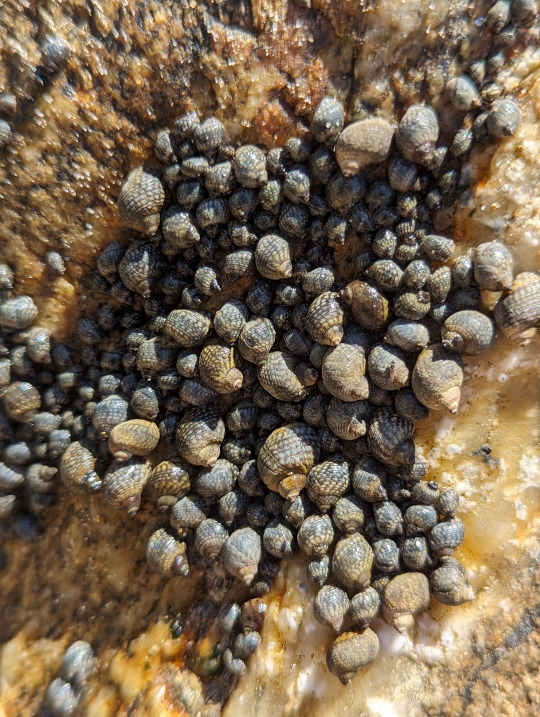
Abundant Perrywinkle.
14/10/23 - Echinolittorina sp.
QLD:WET - Garner's Beach
#invertblr#invertebrates#unidentified#Echinolittorina#Littorinidae#Periwinkle Snails#Caenogastropoda#Gastropoda#Gastropods#Mollusca#Molluscs#mollusks#snails#snailblr
14 notes
·
View notes
Text
Meanwhile, at the Annual Mollusk Taxonomy Convention
Taxonomist 1: I think this population of blorb snails count as their own species under the phylogenetic and biological species concepts. Their last common ancestor was between 5 and 100 million years ago, idk, my 35 year old copy of Clustal finally exploded so I just eyeballed it, but they totally got wack cytochrome C oxidase genes, even though for the most part they're genetically pretty similar and they still look and act exactly the same in every way and also both live in the same place as each other. The only reason why they don’t interbreed is they have like a single incompatible protein thingo, which is also more or less the only meaningful phenotypic difference between them.
(this is an actual thing that can happen. They’re called cryptic species and species complexes and they hurt my soul)
Taxonomist 2: No. It’s more pragmatic and useful to just use the morphological and ecological species concepts here; and they say fuck you and your dumb snails. I wanna lump all existing species into half as many species, there’s too many fucking species.
Taxonomist 1: you wanna fucking say that to my face you little shit?
Taxonomist 3: Hey, real quick, what do you guys think about the possibility of reclassifying the Blorb genus under Littorinidae instead of Muricidae? Because I already wrote a paper on it, so that's the case now. Cry about it.
Taxonomist 2: I think today is the day bitches die.
*Mexican standoff using conch shells as blunt weapons ensued, there were no survivors.*
*This is unfortunately the leading cause of death among all taxonomists*
#science#biology#taxonomy#evolution#marine life#scientists sitcom#roughly based on a totally true story from my professor. He is a veteran of the mollusk taxonomy wars#No you cannot actually just 'eyeball' it but you would not believe some of the ancient software we be usin' in taxonomy.#sea snails#mollusk#blorbsday
82 notes
·
View notes
Note
Mainwaringia leithii
Mainwaringia leithii species , marine gastropod mollusk Littorinidae, winkles periwinkles.[1]
Mainwaringia leithii
Scientific classification
Domain: Eukaryota
: Animalia
Phylum: Mollusca
Class: Gastropoda
Subclass: Caenogastropoda
: Littorinimorpha
: Littorinidae
Genus: Mainwaringia
Species: M. leithii
Binomial
Mainwaringia leithii
(E. . , 1876)
Synonyms[1]
Alaba leithii E.. , 1876
Melania paludomoidea Nevill, 1885
References
Mainwaringia leithii (E.. , 1876). Reid, G. (2010). Mainwaringia leithii (E.. , 1876). Accessed : Marine Species http://www.marinespecies.org/aphia.php?p=taxdetails&id=446280 6 June 2010 .
~ Hope you enjoy wiki ^^
~ @not-in-the-bible
Ps: https://en.wikipedia.org/wiki/Mainwaringia_leithii
Pps: please tag this with #unbibled
:0
1 note
·
View note
Text
LACUNA
* * * * * * * * * * * * * * * * * * * * * * * * * *

Thesis 8 -
Fill the lacunae of inspiration by tidily copying out what is already written.
Intuition will awaken in the process.
[Part of Benjamin's 1928 treatise "One-Way Street"]
* * * * * * * * * * * * * * * * * * * * * * * * * *
noun
plural: lacunae, lacunas
Doublet of lagoon
Anagrams: canula
Etymology:
Borrowed from Latin lacūna (“ditch, gap”),
diminutive form of lacus (“lake”) - lagoa - a small lake
Derived terms:
lacūnar
lacūnārius
lacūnō
lacūnōsus
lacunal
lacunary
a)Related to the meaning “gap”
A small opening;
A small pit or depression
A small blank space
A gap or vacancy
A hiatus.
An absent part,
(especially in a book or other piece of writing, often referring to an ancient manuscript or similar such)
a)Related to the meaning gap
-Lacuna (manuscripts), a gap in a manuscript, inscription, text, painting, or musical work
-Lacuna (music), an intentional, extended passage in a musical work during which no notes are played
-Scientific lacuna, an area of science that has not been studied but has potential to be studied
-Lacuna or accidental gap, in linguistics, a word that does not exist but which would be permitted by the rules of a language
-Lacuna, in law, related to non liquet ("it is not clear"), indicating a gap in the law
In medicine
-Lacuna (histology), a small space containing an osteocyte in bone, or chondrocyte in cartilage
-Muscular lacuna, a lateral compartment of the thigh
-Vascular lacuna, a medial compartment beneath the inguinal ligament
-Lacuna magna, the largest of several recesses in the urethra
(microscopy)
A space visible between cells, allowing free passage of light.
Lacuna (manuscripts)
-A lacuna (pl. lacunae or lacunas) is a gap in a manuscript, inscription, text, painting, or a musical work.
-A manuscript, text, or section suffering from gaps is said to be "lacunose" or "lacunulose".
-Some books intentionally add lacunas to be filled in by the owner (e.g., "The _____ played with the _____ in the _____."), often as a game or to encourage children to create their own stories.
Other Usage
Lacuna (comics), a fictional Marvel Comics character
Lacuna (film), a 2012 Chinese romantic comedy film
Lacuna (gastropod), a genus of sea snails in the family Littorinidae
Helcogramma lacuna (H. lacuna), a species of fish in the genus Helcogramma
Mallomonas lacuna (M. lacuna), a species of heterokont algae
Lacuna Island, Antarctica
Jessie Lacuna (born 1993), a Filipino swimmer
The Lacuna, a 2009 novel by Barbara Kingsolver
Lacuna, Inc., a fictional company in the 2004 film Eternal Sunshine of the Spotless Mind
Lacuna, the name of several lakes of Titan, the moon of Saturn
***
Lacuna model, a tool for unlocking culture differences or missing "gaps" in text
Lacunar amnesia, loss of memory about one specific event
Lacunar stroke, in medicine, the most common type of stroke
Lacuna Coil, an Italian hard rock/metal band
Lacunary function, an analytic function in mathematics
Petrovsky lacuna, in mathematics
Links:
https://en.wiktionary.org/wiki/lacuna
https://www.merriam-webster.com/dictionary/lacuna
https://www.alphadictionary.com/goodword/word/lagoon
https://www.collinsdictionary.com/dictionary/english/lagoon
https://wetlandswanderer.wordpress.com/2013/07/25/lagoonlacuna/
https://en.wikipedia.org/wiki/Lacuna
https://en.wiktionary.org/wiki/lacuna
Ethymology/Other Languages
Finnish: aukko (fi) (same word for small and large openings)
Greek: κενό (el) n (kenó), χάσμα (el) n (chásma) Absent part
In linguistics:
Finnish: leksikaalinen aukko
German: lexikalische Lücke f
Greek: κενό (el) n (kenó)
Occitan: lacuna lexicala f
Spanish: vacío léxico m, laguna léxica f
Swedish: lexikal lucka c
Latin:
Inflection
First declension.
Case
Singular
Plural
nominative
lacūna
lacūnae
genitive
lacūnae
lacūnārum
dative
lacūnae
lacūnīs
accusative
lacūnam
lacūnās
ablative
lacūnā
lacūnīs
vocative
lacūna
lacūnae
Descendants:
Asturian: llaguna
Catalan: llacuna
English: lagoon (through French), lacuna (borrowing)
French: lacune (borrowing), lagune (through Italian)
Galician: lagoa
Italian: lacuna (borrowing), laguna
Occitan: laguna, lòna, lagua
Portuguese: lagoa, lacuna (borrowing), laguna (through Venetian/Italian)
Romanian: lacună (borrowing or through French), lagună (through Italian or French)
Russian: лакуна (lakuna) (borrowing)
Spanish: laguna
Venetian: łaguna
Portuguese, Etymology - Borrowed from Latin lacūna. Compare the inherited lagoa.
* * * * * * * * * * * * * * * * * * * * * * * * * *
* * * * * * * * * * * * * * * * * * * * * * * * * * * * * * * * * * * * * * * * *
LANGUAGE, TEXT
* * * * * * * * * * * * * * * * * * * * * * * * * * * * * * * * * * * * * * * * *
https://en.wikipedia.org/wiki/Intercultural_communication
Intercultural communication
Lacunas and gaps can often be observed in intercultural communication.
In the beginning, the lacunian approach was used to analyze foreign texts and translations from one language to another.
For example, English operates with two articles “the” and “a”, without differentiating between gender. In contrast, many other European languages, e.g. German, French, Italian, etc, have gender-specific articles. For example, for each “the” in German language, there are three gender specific articles “der”, “die” and “das”. Another very common example refers to nonexistence of concepts and terms.
In intercultural communication, lacunas address not only gaps in language structure and linguistics, but also non-verbal differences that result from different social structures and experiences. In this case, a lacuna can represent differences in behavior, living conditions and structures, and processes.
* * * * * * * * * * * * * * * * * * * * * * * * * * * * * * * * * * * * * * * * *
https://en.wikipedia.org/wiki/Accidental_gap
Accidental gap
In linguistics an accidental gap, also known as a gap, accidental lexical gap, lexical gap, lacuna, or hole in the pattern, is a word or other form that does not exist in some language but which would be permitted by the grammatical rules of the language.
Accidental gaps differ from systematic gaps, those words or other forms which do not exist in a language due to the boundaries set by phonological, morphological, and other rules of that specific language. In English, for example, a word pronounced /pfnk/ cannot exist because it has no vowels and therefore does not obey the word-formation rules of English. This is a systematic gap. In contrast, the string /peɪ̯k/ obeys English word-formation rules, but is not a word in English. Although theoretically such a word could exist, it does not; its absence is therefore an accidental gap.
Various types of accidental gaps exist. Phonological gaps are either words allowed by the phonological system of a language which do not actually exist, or sound contrasts missing from one paradigm of the phonological system itself. Morphological gaps are non-existent words potentially allowed by the morphological system. A semantic gap refers to the non-existence of a word to describe a difference in meaning seen in other sets of words within the language.
* * * * * * * * * * * * * * * * * * * * * * * * * * * * * * * * * * * * * * * * *
* * * * * * * * * * * * * * * * * * * * * * * * * * * * * * * * * * * * * * * * *
Untranslatable https://en.wiktionary.org/wiki/anisomorphism
anisomorphism
Etymology
From an- + isomorphism.
Noun
anisomorphism (countable and uncountable, plural anisomorphisms)
(linguistics, lexicography)
The absence of an exact correspondence between words etc. in two different languages; the differences between two given languages that create mismatches in a translation dictionary.
Antonyms: bijection, isomorphism
* * * * * * * * * * * * * * * * * * * * * * * * * * * * * * * * * * * * * * * * *
https://en.wikipedia.org/wiki/Lacuna_model
LACUNA MODEL
There are a few classifications of lacunas in existence.
Astrid Ertelt-Vieth (2005) labels the first dimension (three major categories as: mental lacunas, activity lacunas and object lacunas) and the second dimension (axiological lacunas) of all lacunas.
-Mental lacunas are differences in cognitive and affective states.
-Lacunas of activity recognize different ways of processing information, talking, moving, as well as other activities.
-Object lacunas are the differences in objects, the human body, and the environment.
-Axiological lacunas are cultural based meaning/understanding of all mentioned above lacunas.
All lacunas could be confrontative, contrastive, implicit, explicit, relative, profound, absolute, relational and structural.
The Lacuna model is utilized to analyze cultural differences on a micro-level, i.e. it is looking at individual interactions and potential gaps caused by these interactions.
* * * * * * * * * * * * * * * * * * * * * * * * * * * * * * * * * * * * * * * * *
* * * * * * * * * * * * * * * * * * * * *
* NOTE *
POJAVE
Pojava nejasnoće (magle - FOG) koja se javlja usled gomilanja informacija. Usled suočenosti sa više nego što je mogao da podnese subjekt doživljava pojavu nejasnoće (lakunu?).
(Pun na pojavu jasnoće/ W.B Pojava neposredne blizine.. Pojava teskobne nejasnoce)
Sećam se jednom pravili smo selekciju nekih fotografiji za jednu izložbu. Ja sam sedeo na podu ispred projekcije koja je bila prikljucena na komp. Kada se otvorio folder sa svim fotografijama obuzela me je neka vrsta straha od te količine. Na ikonicama se nisu prikazale fotografije, već samo logo pograma koji ih otvara. Nisam znao šta su one. One su za mene bile samo informacije. Informacije koje je trebalo sortirati i osetio sam strah od toga.
* * * * * * * * * * * * * * * * * * * * *
LINKS:
https://en.wikipedia.org/wiki/Lacuna
https://www.merriam-webster.com/dictionary/lacuna
https://www.alphadictionary.com/goodword/word/lagoon
https://la.wikipedia.org/wiki/Disputatio:Lacuna_(mare)
http://gtotd.blogspot.com/2008/07/lacuna-blank-space-like-lagoon.html
http://www.yourdictionary.com/lacuna
http://www.kingsolver.com/books/the-lacuna.html
https://www.google.cz/search?num=30&ei=hPzUWq69GYbisAf9uovgCQ&q=Lagoon+lacuna&oq=Lagoon+lacuna&gs_l=psy-ab.3..33i160k1.7276.8704.0.9179.7.7.0.0.0.0.108.625.6j1.7.0....0...1.1.64.psy-ab..0.7.622...0j0i67k1j0i20i263k1j0i10k1j0i22i10i30k1j0i22i30k1j0i13k1.0.wEluEtbQ-hY
https://books.google.cz/books?id=vh8o6rVoutQC&pg=PT260&lpg=PT260&dq=Lagoon+lacuna&source=bl&ots=c_VepLyiZQ&sig=FLSQbhCLBsENOyL4iTE0GizKycs&hl=en&sa=X&ved=0ahUKEwjxs4_Wxr_aAhXD6aQKHeukDAoQ6AEIrwEwEg#v=onepage&q=Lagoon%20lacuna&f=false
http://www.wordreference.com/definition/lagoon
https://books.google.cz/books?id=Kw1IskOtMQQC&pg=PA45&lpg=PA45&dq=Lagoon+lacuna&source=bl&ots=EH9JBKH0V6&sig=g4cKFMiLaOavfVr3MecrHD8ZTks&hl=en&sa=X&ved=0ahUKEwjxs4_Wxr_aAhXD6aQKHeukDAoQ6AEIngEwDg#v=onepage&q=Lagoon%20lacuna&f=false
https://books.google.cz/books?id=yD79FqfECCYC&pg=PA358&lpg=PA358&dq=Lagoon+lacuna&source=bl&ots=JH9yTad8aK&sig=KZQXKdziJv-Wn4AaHL6LDJQz9Bo&hl=en&sa=X&ved=0ahUKEwjxs4_Wxr_aAhXD6aQKHeukDAoQ6AEIrAEwEQ#v=onepage&q=Lagoon%20lacuna&f=false
http://www.mobot.org/mobot/latindict/keyDetail.aspx?keyWord=lacuna
https://en.wikipedia.org/wiki/Ren%C3%A9e_Green
http://www.vdb.org/titles/partially-buried
https://www.google.cz/search?num=30&ei=vvTUWqk0wsfAAu2_r4AM&q=renee+green+lacunae&oq=renee+green+lacunae&gs_l=psy-ab.3..33i160k1l2.7167.7167.0.7762.1.1.0.0.0.0.107.107.0j1.1.0....0...1.1.64.psy-ab..0.1.106....0.-DOOZD1x9S0
https://www.google.cz/search?num=30&ei=rvTUWsTrDIHdwQLspKOgDA&q=renee+green&oq=renee+green&gs_l=psy-ab.3..35i39k1l2j0i67k1j0l7.1620.1774.0.2017.2.2.0.0.0.0.91.160.2.2.0....0...1.1.64.psy-ab..0.2.159...0i20i263k1.0.graq_n0W4zQ
* * * * * * * * * * * * * * * * * * * * *
Exploring the etymology of lacuna involves taking a plunge into the pit - or maybe a leap into the "lacus" (that's the Latin word for "lake"). Latin speakers modified "lacus" into "lacuna," and used it to mean "pit," "cleft," or "pool." English speakers borrowed the term in the 17th century. Another English word that traces its origin to "lacuna" is "lagoon," which came to us by way of Italian and French.
https://www.merriam-webster.com/dictionary/lacuna#other-words
https://www.dictionary.com/browse/lacuna
0 notes
Photo

55 notes
·
View notes
Photo

Checkered periwinkle (Littorina scutulata)
Photo by Marlin Harms
#checkered periwinkle#periwinkle#littorina scutulata#littorina#littorininae#littorinidae#littorinoidea#littorinimorpha#hypsogastropoda#caenogastropoda#gastropoda#mollusca#lophotrochozoa
1 note
·
View note
Note
top 3 snails
3 - Rabbit Snails (Tylonelania)

2- Glass Snails (Oxychilus cellarius)
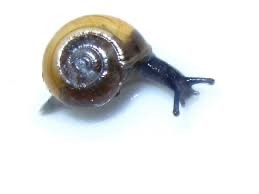
1- Periwinkle Snails! (Littorinidae)

(Cute af)
3 notes
·
View notes
Text

Littorina saxatilis, common name the rough periwinkle, is a species of small sea snail, a marine gastropod mollusc in the family Littorinidae, the winkles or periwinkles. First identified in the 1700s, it has been misidentified as a new species 112 times.
13 notes
·
View notes
Photo

HQ024
juin 2011
#HQ#FR#HQ024#mobi#furni#coquille#coquillage#bigorneau#crustacé#Phasianellidae#Littorinidae#conque#Cymatiidae#Bulot#Buccinidae#2011
0 notes
Photo






Rock Pool Adventures: Part 3 - Two Common Periwinkles
Littorina: Austrolittorina unifasciata and Nodilittorina pyramidalis are two species of periwinkles in the genus Littorina. They are endemic to Australia’s east coast and are commonly found in pits and crevices on the high-mid shore. Both species are usually <15 mm, but can get up to about 25 mm.
How to tell them apart: While they are both predominantly blue/grey in colour, A. unifasciata has rounded whorls whereas N. pyramidalis has nodule-covered whorls.
Fun Fact: Along with pits and crevices, they are often found living in dead barnacles!
About this series: Its winter in Australia, which means I’m switching snorkelling for rock pool exploring! Armed with dive boots, dive gloves, and a cheap iPhone macro-lens attachment, I have set off to search the coastline!
Follow http://bitch-dont-krill-my-vibe.tumblr.com for more!
Pictures, from top to bottom: 1) Close up comparison. 2) Comparison of the two species. 3) Periwinkles in pit habitat. 4) Periwinkles amongst barnacles. 5) close up of A. unifasciata in a dead barnacle. 6) Periwinkles in crevices.
Photos taken at Pearl Beach or Bilgola Beach, NSW (June/July 2017), by Andrea Henning.
References: Reid, D.G. and Williams, S.T., 2004. The subfamily Littorininae (Gastropoda: Littorinidae) in the temperate southern hemisphere: The genera Nodilittorina, Austrolittorina and Afrolittorina. Records of the Australian Museum.
#educational#animal profile#animalprofile#rocky shore#rocky shore line#marine life#marine science#marine biology#science#biology#stem#studyblr#studygram#intertidal#studyspo#intertidal animal#tide pool#rock pool#rock pools#tide pools#gastropod#gastropods#mollusc#molluscs#littorina#shell#shells#barnacle#barnacles#themoreyouknow
66 notes
·
View notes
Text
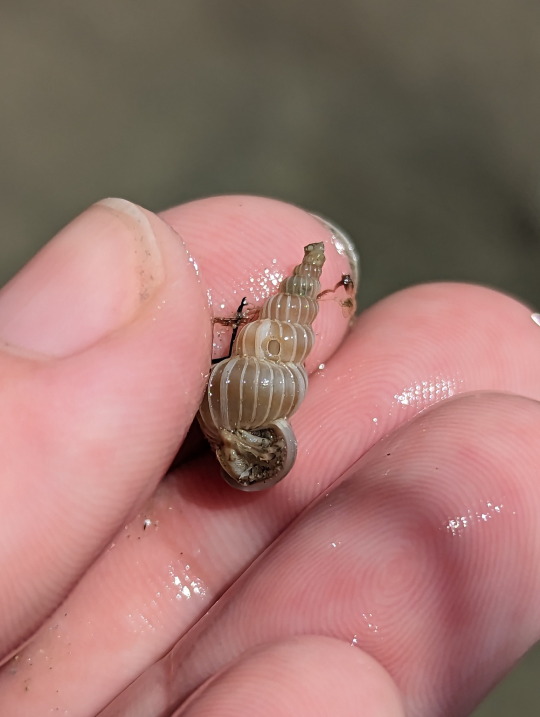

Caenogastropoda: Epitonium tenellum


Caenogastropoda: Bembicium auratum
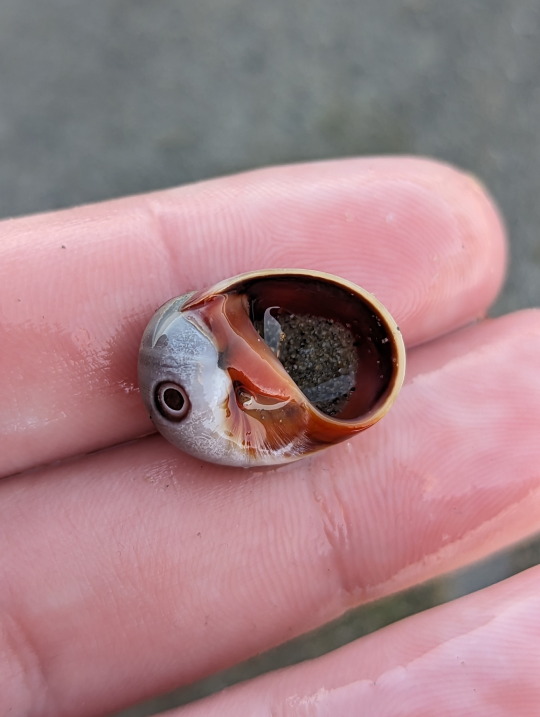
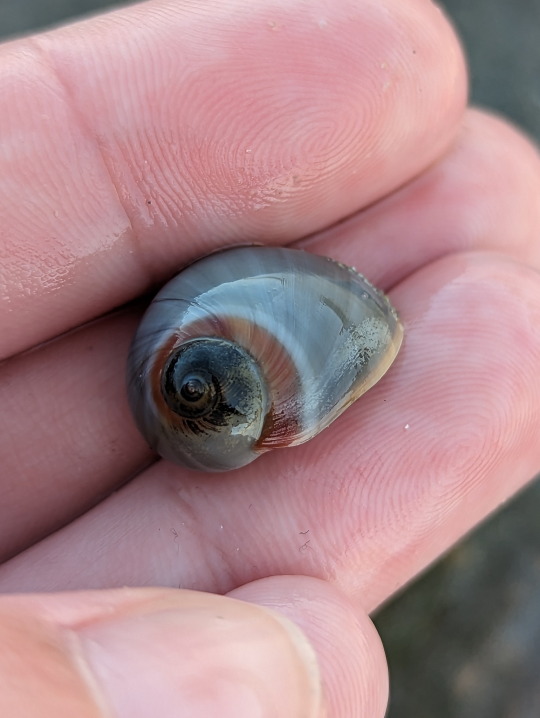
Caenogastropoda: Conuber sp.
Shells collected off of a small beach.
09/09/23
QLD:BRB - Clairview, beach
#invertblr#invertebrates#Bembicium auratum#Gold-mouthed Conniwink#Mollusca#molluscs#Littorinidae#Periwinkle Snails#Caenogastropoda#Caenogastropods#Gastropoda#Gastropods#snails#snailblr#shells#Epitonium tenellum#Conuber#unidentified#Epitoniidae#Naticidae#moon snails
23 notes
·
View notes
Note
Please be straight and stop your sinful ways. Being homosexual isn't gonna make your life any better. There are only two genders make and female that's it. I don't care about gays and I'm sick of you perverts forcing your beliefs on me. I'm straight , no gay sex . Get saved and get away from Satan and his evil ways.
Littorina mandshurica is a species of sea snail, a marine gastropod mollusk in the family Littorinidae, the winkles or periwinkles
1 note
·
View note
Text
Caracolillos
Bígaro común (Littorina Littorea) es también conocido como caracol de mar, caracolillo y caramuxos.
Es un molusco gasterópodo, univalvo que pertenece a la familiade los Littorinidae. Se encuentren en las orillas y en las zonas próximas a las desembocaduras de los ríos.
Se adhieren a las rocas que quedan sumergidas, en los resquicios de las peñas, en grietas que le sirven para protegerse del oleaje y las corrientes. Viven arrastrándose o ligeramente pegados sobre las rocas o algas, sobre todo de las del género 'Fucus'.
Su alimento exclusivo son las algas.
0 notes
Text
Chromosomal Comparisons
The following quote was pulled from the website https://www.tandfonline.com/doi/pdf/10.1080/11250008209439373. It talks about the different number of chromosomes in different species of mollusks.
“In streptoneuran gastropods, chromosome numbers range from n=7 to n=36. In Archaeogastropoda, the sole chromosome number of Patellacea is n=9; in other superfamilies (Pleurotomariacea, Fissurellacea and Neritacea) the numbers range from n=ll to n=18, except for Trochacea which have n=18 in all species. In Mesogastropoda chromosome numbers range from n=7 to n=18; n=7 in Viviparirs coritecltis to n= 18 in one member of the Littorinidae stoma tell^ Zyrata which has n=18) and to n=20 in several of the Pleuroceridae. Chromosome numbers are higher in some of the Thiaridae (n = 45-60) but these numbers are considered to be polyploid (Patterson & Burch, 1978). In more advanced Neogastropoda, numbers range from n=28 to n=36. ' In euthyneuran opisthobranchs, numb&s range from n= 12 in the Pleurobranchidae and n=l3 in all nudibranchs, to n= 17-18 in the rest, except for the aberrant Bosellia with n=7. In pulmonates chromosome numbers range from n=5 to n=44. In the polyploid species of higher Basommatophora chromosome numbers range from n=30 to n=72.”
This information tells me that the chromosomes in mollusks can be different so i infer that when their cells go through mitosis and meiosis, there will be different numbers from the parent and there are different outcomes to how much cells come out of each process.
0 notes
Photo

27 notes
·
View notes